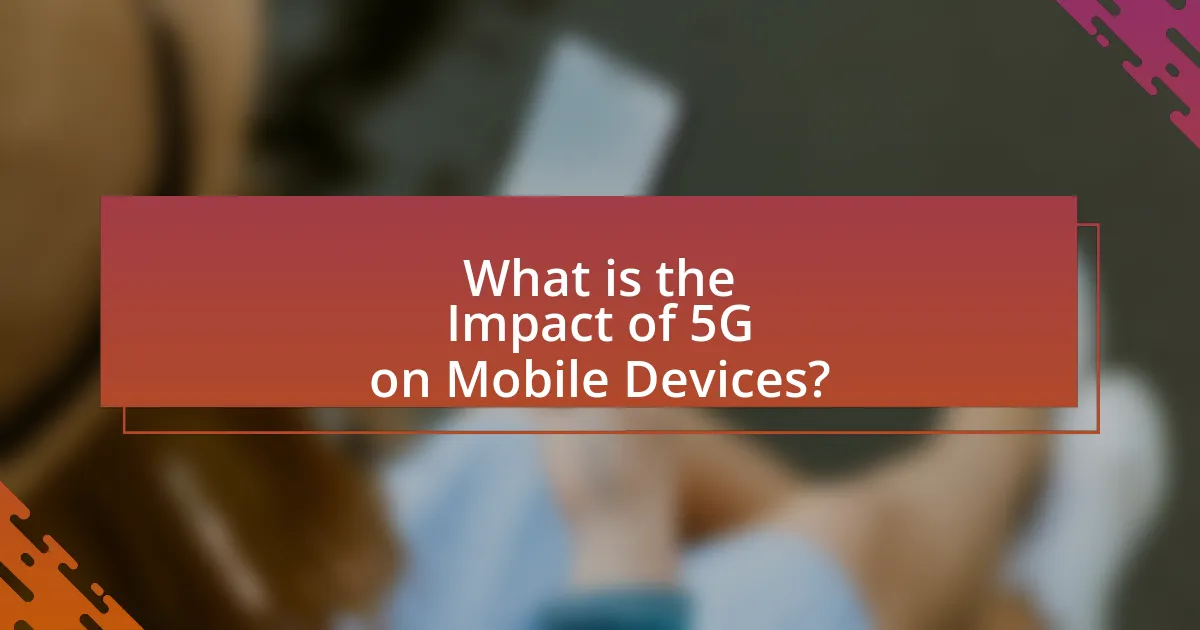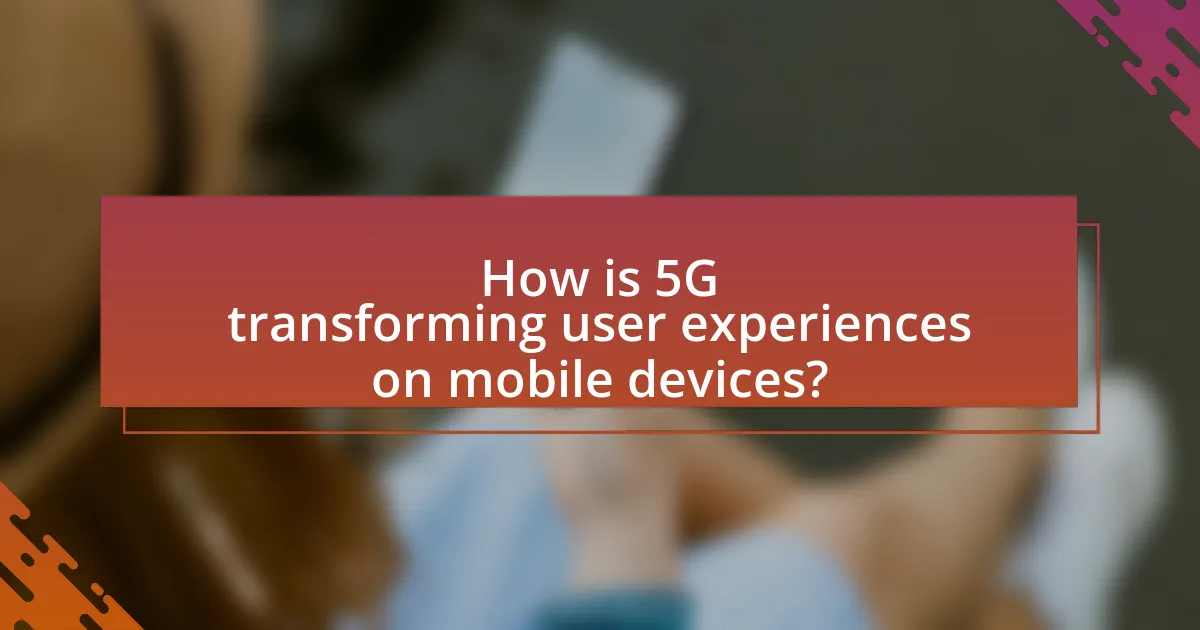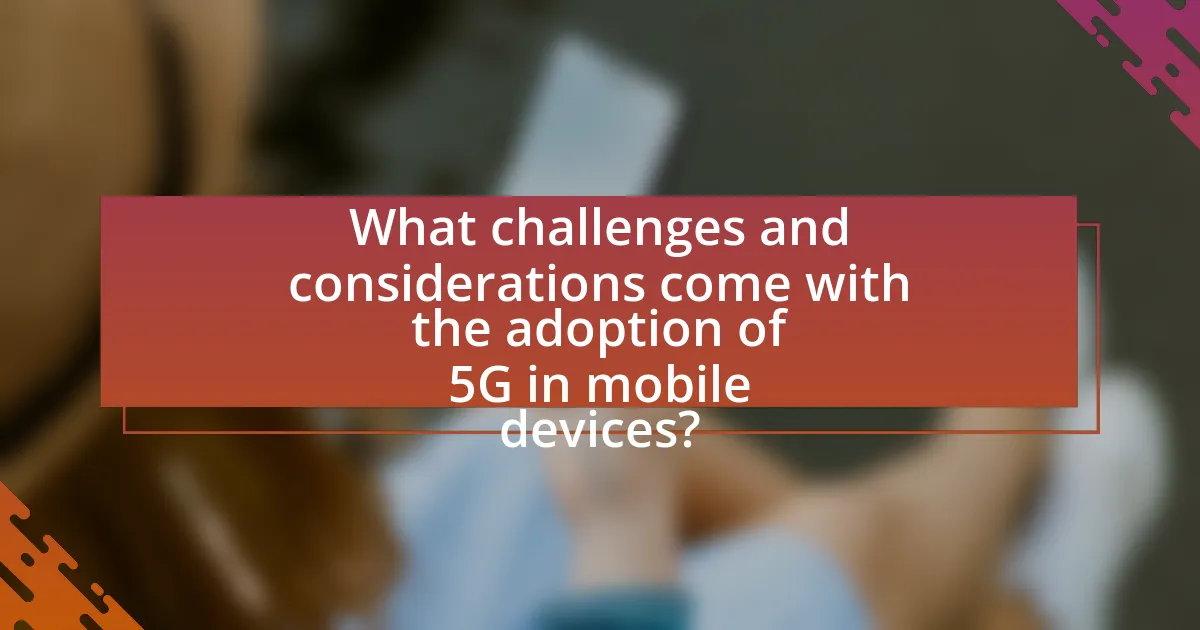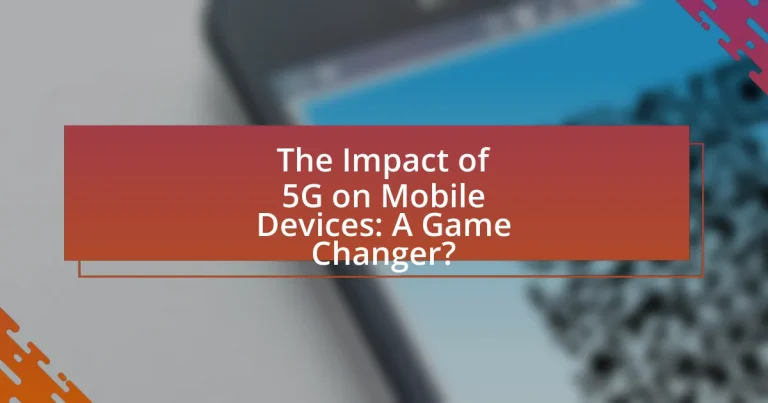The article examines the transformative impact of 5G technology on mobile devices, highlighting its significant enhancements in data speeds, latency, and connectivity. With download speeds exceeding 10 Gbps and latency as low as 1 millisecond, 5G enables seamless streaming, real-time gaming, and supports a higher density of connected devices, facilitating the growth of the Internet of Things (IoT). The article also discusses the differences between 5G and previous generations, the implications for mobile applications, and the challenges associated with 5G adoption, including infrastructure requirements and security concerns. Overall, 5G is positioned as a game changer for mobile technology, promising substantial economic benefits and advancements in user experience.

What is the Impact of 5G on Mobile Devices?
The impact of 5G on mobile devices is significant, as it enables faster data speeds, lower latency, and improved connectivity. With 5G technology, mobile devices can achieve download speeds exceeding 10 Gbps, which is up to 100 times faster than 4G. This enhancement allows for seamless streaming of high-definition content, real-time gaming, and efficient use of augmented and virtual reality applications. Additionally, 5G supports a higher density of connected devices, facilitating the Internet of Things (IoT) by allowing millions of devices to connect simultaneously without degradation in performance. The deployment of 5G networks is projected to create economic benefits, with estimates suggesting a contribution of $13.2 trillion to the global economy by 2035, according to a report by IHS Markit.
How does 5G technology differ from previous generations?
5G technology differs from previous generations primarily through its significantly higher data transfer speeds, lower latency, and increased capacity for connected devices. While 4G networks typically offer speeds up to 1 Gbps, 5G can achieve speeds exceeding 10 Gbps, enabling faster downloads and smoother streaming. Additionally, 5G reduces latency to as low as 1 millisecond compared to 30-50 milliseconds in 4G, which enhances real-time communication and responsiveness in applications like gaming and autonomous vehicles. Furthermore, 5G supports a greater number of simultaneous connections, allowing up to 1 million devices per square kilometer, compared to 4G’s limit of around 100,000 devices, which is crucial for the Internet of Things (IoT) expansion. These advancements position 5G as a transformative technology for mobile devices and various industries.
What are the key features of 5G technology?
The key features of 5G technology include enhanced data speeds, reduced latency, increased capacity, and improved connectivity. Enhanced data speeds can reach up to 10 Gbps, significantly faster than 4G, enabling quicker downloads and smoother streaming. Reduced latency, often as low as 1 millisecond, allows for real-time communication, which is crucial for applications like autonomous driving and remote surgery. Increased capacity supports a higher number of devices per square kilometer, facilitating the Internet of Things (IoT) expansion. Improved connectivity ensures more reliable connections in crowded areas, enhancing user experience in urban environments. These features collectively position 5G as a transformative technology for mobile devices and various industries.
How does 5G enhance mobile connectivity?
5G enhances mobile connectivity by providing significantly higher data speeds, reduced latency, and increased capacity for simultaneous connections. Specifically, 5G networks can achieve download speeds of up to 10 Gbps, which is up to 100 times faster than 4G, allowing for quicker access to applications and content. Additionally, 5G reduces latency to as low as 1 millisecond, enabling real-time communication and responsiveness, which is crucial for applications like gaming and autonomous vehicles. Furthermore, 5G supports a higher density of devices, accommodating up to 1 million devices per square kilometer, which is essential for the growing Internet of Things (IoT) ecosystem. These advancements collectively transform mobile connectivity, making it more efficient and capable of supporting a wide range of applications and services.
What potential changes can we expect in mobile device performance with 5G?
5G technology is expected to significantly enhance mobile device performance by providing faster data speeds, lower latency, and improved connectivity. Specifically, 5G can deliver download speeds up to 10 Gbps, which is approximately 100 times faster than 4G, enabling quicker access to applications and content. Additionally, 5G reduces latency to as low as 1 millisecond, allowing for real-time communication and responsiveness in applications such as gaming and augmented reality. Furthermore, 5G supports a higher density of connected devices, facilitating the Internet of Things (IoT) and enabling seamless connectivity for smart devices. These advancements collectively contribute to a more efficient and powerful mobile experience.
How does 5G affect download and upload speeds?
5G significantly increases both download and upload speeds compared to previous generations like 4G. Specifically, 5G can achieve download speeds exceeding 10 Gbps and upload speeds around 1-3 Gbps under optimal conditions. This enhancement is due to advanced technologies such as millimeter waves, massive MIMO (Multiple Input Multiple Output), and beamforming, which allow for greater data transmission capacity and efficiency. Studies indicate that users can experience up to 100 times faster speeds with 5G, enabling quicker access to content and improved performance for applications requiring high bandwidth.
What improvements can be seen in latency and responsiveness?
5G technology significantly improves latency and responsiveness, reducing latency to as low as 1 millisecond compared to 4G’s average of 30-50 milliseconds. This enhancement allows for near-instantaneous communication between devices, which is crucial for applications like real-time gaming, augmented reality, and autonomous vehicles. The increased responsiveness is supported by the higher data transfer rates of 5G, which can reach up to 10 Gbps, enabling faster data processing and reduced delays in user interactions.
What are the implications of 5G for mobile applications?
5G significantly enhances mobile applications by providing faster data speeds, lower latency, and increased connectivity. These improvements enable applications to deliver real-time experiences, such as augmented reality and high-definition video streaming, which were previously limited by slower networks. For instance, 5G can achieve download speeds up to 10 Gbps, compared to 4G’s maximum of around 1 Gbps, allowing for seamless content delivery and interactive features. Additionally, the reduced latency of 1 millisecond in 5G networks supports applications that require immediate feedback, such as remote surgery and autonomous vehicles, thereby expanding the potential use cases for mobile applications.
How will 5G enable new app functionalities?
5G will enable new app functionalities by providing significantly higher data speeds, lower latency, and increased connectivity. These enhancements allow applications to process and transmit data in real-time, facilitating advanced features such as augmented reality, virtual reality, and seamless streaming of high-definition content. For instance, 5G networks can support up to 10 Gbps speeds, compared to 4G’s maximum of 1 Gbps, which enables apps to deliver richer user experiences and more complex functionalities. Additionally, the reduced latency of around 1 millisecond in 5G networks compared to 30-50 milliseconds in 4G allows for instantaneous interactions in applications, making real-time gaming and remote control of devices more viable.
What types of applications will benefit most from 5G?
Applications that will benefit most from 5G include augmented reality (AR), virtual reality (VR), autonomous vehicles, smart cities, and Internet of Things (IoT) devices. These applications require high-speed data transfer, low latency, and the ability to connect a vast number of devices simultaneously. For instance, AR and VR applications can deliver immersive experiences with minimal lag, enhancing user engagement in gaming and training simulations. Autonomous vehicles rely on real-time data processing and communication with other vehicles and infrastructure, which 5G can facilitate effectively. Smart cities utilize 5G to manage resources efficiently, improving traffic flow and energy consumption. IoT devices benefit from 5G’s capacity to support a large number of connections, enabling smarter homes and industries.

How is 5G transforming user experiences on mobile devices?
5G is transforming user experiences on mobile devices by significantly enhancing data speeds, reducing latency, and enabling more reliable connections. With download speeds reaching up to 10 Gbps, users can stream high-definition content seamlessly and download large files in seconds. The latency reduction to as low as 1 millisecond allows for real-time interactions in applications such as gaming and video conferencing, improving overall responsiveness. Additionally, 5G supports a higher density of connected devices, facilitating the growth of IoT applications that enhance user convenience and automation. These advancements collectively create a more immersive and efficient mobile experience.
What enhancements in user experience can be expected with 5G?
5G technology significantly enhances user experience by providing faster data speeds, lower latency, and improved connectivity. With data speeds reaching up to 10 Gbps, users can download large files in seconds and stream high-definition content without buffering. The latency reduction to as low as 1 millisecond enables real-time interactions, which is crucial for applications like online gaming and virtual reality. Additionally, 5G supports a higher density of connected devices, allowing seamless connectivity in crowded areas, which enhances the overall user experience in urban environments. These advancements are backed by industry reports, such as those from the International Telecommunication Union, which highlight the transformative potential of 5G in improving mobile device performance and user satisfaction.
How does 5G improve streaming and gaming experiences?
5G significantly enhances streaming and gaming experiences by providing higher data transfer speeds, lower latency, and increased network capacity. With speeds reaching up to 10 Gbps, 5G allows for seamless streaming of high-definition content without buffering. The reduced latency, often below 10 milliseconds, ensures that gaming experiences are more responsive, minimizing lag and improving real-time interactions. Additionally, 5G’s ability to connect more devices simultaneously without degradation of service supports multiplayer gaming and high-quality streaming for multiple users in the same area. These advancements lead to a more immersive and enjoyable experience for users engaged in streaming and gaming activities.
What role does 5G play in augmented and virtual reality applications?
5G plays a crucial role in augmented and virtual reality applications by providing high-speed data transfer, low latency, and increased bandwidth. These features enable seamless streaming of high-quality graphics and real-time interactions, which are essential for immersive experiences in AR and VR. For instance, 5G networks can support data rates exceeding 10 Gbps, allowing for the transmission of complex 3D environments without lag, thus enhancing user engagement and satisfaction. Additionally, the low latency of 5G, often below 10 milliseconds, minimizes delays in user input and system response, which is vital for applications requiring immediate feedback, such as gaming and remote collaboration.
How does 5G impact mobile device design and features?
5G significantly impacts mobile device design and features by necessitating enhanced hardware capabilities and new functionalities. Mobile devices must incorporate advanced antennas and chipsets to support higher frequencies and faster data rates, which leads to a shift in design to accommodate these components. For instance, devices are now designed with multiple antennas to enable MIMO (Multiple Input Multiple Output) technology, improving connectivity and speed. Additionally, 5G requires better thermal management solutions due to increased power consumption, prompting manufacturers to innovate in cooling technologies. The introduction of features like improved camera systems and augmented reality applications is also driven by the high bandwidth and low latency of 5G, allowing for richer user experiences.
What new hardware requirements are necessary for 5G compatibility?
5G compatibility requires new hardware components, including 5G-capable chipsets, advanced antennas, and improved radio frequency (RF) components. These chipsets must support higher frequency bands, such as millimeter waves, which enable faster data transmission and lower latency. Additionally, devices need multiple-input multiple-output (MIMO) technology to enhance signal quality and capacity. The integration of these components is essential for devices to effectively utilize the enhanced capabilities of 5G networks, as evidenced by the deployment of 5G networks globally, which necessitates hardware upgrades to meet the new standards set by the International Telecommunication Union (ITU).
How might battery life be affected by 5G technology?
5G technology may negatively affect battery life due to its higher energy demands compared to previous generations. The increased data transmission speeds and the need for more frequent communication with cell towers require mobile devices to use more power, leading to faster battery depletion. Research indicates that devices operating on 5G networks can consume up to 20% more battery than those on 4G networks, particularly when utilizing features like high-definition video streaming or augmented reality applications. This increased energy consumption is primarily attributed to the advanced antenna technology and the need for devices to maintain a stable connection in areas with varying signal strength.

What challenges and considerations come with the adoption of 5G in mobile devices?
The adoption of 5G in mobile devices presents several challenges and considerations, including infrastructure requirements, device compatibility, and security concerns. Infrastructure for 5G requires significant investment in new base stations and fiber-optic networks, as 5G operates at higher frequencies that have shorter ranges. This necessitates a denser network of antennas, which can be costly and time-consuming to deploy. Device compatibility is another challenge, as existing mobile devices may not support 5G technology, requiring consumers to upgrade their devices. Additionally, security concerns arise with 5G networks due to the increased number of connected devices and potential vulnerabilities in the network architecture. According to a report by the GSMA, the global economic impact of 5G could reach $2.2 trillion by 2030, highlighting the importance of addressing these challenges to fully realize the benefits of 5G technology.
What are the potential drawbacks of 5G technology?
The potential drawbacks of 5G technology include increased infrastructure costs, potential health concerns, and limited coverage in rural areas. The deployment of 5G requires significant investment in new infrastructure, including antennas and fiber optic cables, which can strain budgets for telecommunications companies. Health concerns arise from the higher frequency electromagnetic fields used in 5G, with some studies suggesting potential links to health issues, although conclusive evidence is still debated. Additionally, 5G networks may not reach remote or rural areas effectively, leading to a digital divide where urban populations benefit more than those in less populated regions.
How does 5G affect network security and privacy?
5G significantly affects network security and privacy by introducing new vulnerabilities while enhancing encryption and authentication protocols. The increased number of connected devices in 5G networks expands the attack surface for cyber threats, making it easier for malicious actors to exploit weaknesses. For instance, the use of network slicing in 5G allows for the segmentation of networks, which can improve security but also creates potential entry points if not properly managed. Additionally, 5G employs advanced encryption methods, such as 256-bit encryption, which enhances data protection during transmission. However, the reliance on cloud-based services and edge computing in 5G can lead to privacy concerns, as user data may be processed and stored in multiple locations, increasing the risk of unauthorized access.
What are the concerns regarding infrastructure and coverage?
Concerns regarding infrastructure and coverage primarily involve the adequacy of existing networks to support 5G technology and the geographic disparities in service availability. Many regions lack the necessary fiber optic cables and small cell installations required for optimal 5G performance, leading to inconsistent service quality. According to a report by the Federal Communications Commission, as of 2021, approximately 19 million Americans still lack access to high-speed broadband, which directly impacts the rollout of 5G services. Additionally, urban areas may experience congestion due to high user density, while rural areas may face delays in infrastructure development, exacerbating the digital divide.
What should consumers consider when upgrading to 5G devices?
Consumers should consider network compatibility, device performance, and pricing when upgrading to 5G devices. Network compatibility is crucial as not all areas have 5G coverage; consumers should verify that their location supports 5G networks from their carrier. Device performance is important because 5G devices often come with enhanced features, such as improved processing power and camera capabilities, which can significantly enhance user experience. Pricing is also a key factor, as 5G devices typically have a higher upfront cost compared to 4G devices, and consumers should evaluate whether the benefits of 5G justify the investment.
How can users determine if they need a 5G device now?
Users can determine if they need a 5G device now by assessing their data usage needs, location coverage, and device compatibility. If users frequently engage in high-bandwidth activities such as streaming 4K video, online gaming, or using augmented reality applications, a 5G device can significantly enhance their experience due to faster speeds and lower latency. Additionally, users should check if their area has robust 5G network coverage; as of 2023, major cities and urban areas have seen substantial 5G rollout, making it more accessible. Lastly, users should consider whether their current devices are compatible with 5G networks; many newer smartphones support 5G, while older models do not.
What are the best practices for maximizing 5G benefits on mobile devices?
To maximize 5G benefits on mobile devices, users should ensure their devices are 5G-compatible and utilize 5G networks whenever available. This compatibility allows access to faster data speeds, lower latency, and improved connectivity. Additionally, users should enable 5G settings in their device’s network options to prioritize 5G connections over 4G or lower networks. Regularly updating device software is also crucial, as manufacturers often release updates that enhance 5G performance and security. Furthermore, users can optimize their data plans by selecting options that specifically support 5G usage, ensuring they can fully leverage the capabilities of the network. According to a report by the GSMA, 5G networks can deliver speeds up to 100 times faster than 4G, highlighting the importance of utilizing compatible devices and networks to experience these benefits.
What future trends can we anticipate in mobile devices with 5G technology?
Future trends in mobile devices with 5G technology include enhanced connectivity, increased data speeds, and the proliferation of IoT devices. 5G technology enables download speeds up to 10 Gbps, significantly faster than 4G, which allows for seamless streaming, gaming, and augmented reality experiences. Additionally, the low latency of 5G, around 1 millisecond, facilitates real-time communication and supports applications like remote surgery and autonomous vehicles. The expansion of 5G networks is expected to drive the development of smart cities and connected devices, with estimates suggesting that there will be over 75 billion IoT devices by 2025, all benefiting from 5G connectivity.
How will 5G influence the development of IoT devices?
5G will significantly enhance the development of IoT devices by providing faster data transfer speeds, lower latency, and increased connectivity. This technology enables IoT devices to communicate more efficiently, allowing for real-time data processing and improved functionality. For instance, 5G networks can support up to one million devices per square kilometer, compared to 4G’s maximum of 100,000 devices, facilitating the deployment of smart cities and advanced industrial applications. Additionally, the reduced latency of 5G, which can be as low as one millisecond, allows for instantaneous communication between devices, crucial for applications like autonomous vehicles and remote healthcare. These advancements will drive innovation and expand the capabilities of IoT devices across various sectors.
What innovations in mobile technology might emerge from 5G advancements?
5G advancements are likely to lead to innovations in mobile technology such as enhanced augmented reality (AR) and virtual reality (VR) experiences, improved Internet of Things (IoT) connectivity, and faster mobile broadband speeds. The increased bandwidth and lower latency of 5G networks enable seamless integration of AR and VR applications, allowing for more immersive experiences in gaming, education, and training. Additionally, 5G’s ability to connect a vast number of devices simultaneously enhances IoT applications, facilitating smart cities and connected vehicles. According to a report by the GSMA, 5G is expected to support over 1.5 billion IoT connections by 2025, demonstrating its potential to revolutionize mobile technology.


